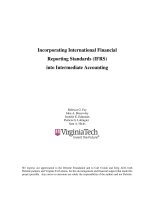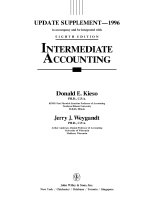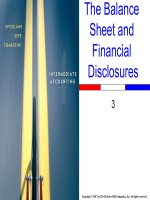Intermediate Accounting - Chap001 docx
Bạn đang xem bản rút gọn của tài liệu. Xem và tải ngay bản đầy đủ của tài liệu tại đây (580.45 KB, 57 trang )
Copyright © 2007 by The McGraw-Hill Companies, Inc. All rights reserved.
Environmental and
Theoretical Structure
of Financial
Accounting
1
Insert Book Cover
Picture
1-2
Learning Objectives
Describe the function and primary
focus of financial accounting.
1-3
Financial Accounting Environment
Profit-oriented
companies
Not-for-profit
entities
Households
Providers of
Financial Information
External
User Groups
Investors
Creditors
Employees
Labor unions
Customers
Suppliers
Government
agencies
Financial
intermediaries
Relevant
Financial
Information
1-4
Financial Accounting Environment
Relevant financial information is provided
primarily through financial statements
and related disclosure notes.
Balance Sheet
Income Statement
Statement of Cash Flows
Statement of Shareholders’ Equity
1-5
The Economic Environment and
Financial Reporting
A sole proprietorship
is owned by a
single individual.
A sole proprietorship
is owned by a
single individual.
A partnership is
owned by two or
more individuals.
A partnership is
owned by two or
more individuals.
A corporation is owned
by stockholders,
frequently numbering
in the tens of thousands
in large corporations.
A corporation is owned
by stockholders,
frequently numbering
in the tens of thousands
in large corporations.
A highly-developed system of financial
reporting is necessary to communicate
financial information from a corporation
to its many shareholders.
A highly-developed system of financial
reporting is necessary to communicate
financial information from a corporation
to its many shareholders.
1-6
Investment-Credit Decisions
A Cash Flow Perspective
Corporate shareholders receive cash from
their investments through . . .
Periodic dividend distributions from the
corporation.
The ultimate sale of the ownership shares of
stock.
1-7
Accounting information should help
investors evaluate the amount, timing,
and uncertainty of the enterprise’s
future cash flows.
Investment-Credit Decisions
A Cash Flow Perspective
1-8
Learning Objectives
Explain the difference between
cash and accrual accounting.
1-9
Cash Versus Accrual Accounting
Cash Basis Accounting
Revenue is recognized when cash is received.
Expenses are recognized when cash is paid.
1-10
Cash Versus Accrual Accounting
Cash Basis Accounting
Carter Company has sales on account totaling
$100,000 per year for three years. Carter collected
$50,000 in the first year and $125,000 in the second
and third years. The company prepaid $60,000 for
three years’ rent in the first year. Utilities are $10,000
per year, but in the first year only $5,000 was paid.
Payments to employees are $50,000 per year.
Let’s look at the cash flows.
1-11
Cash Versus Accrual Accounting
Cash Basis Accounting
1-12
Cash Versus Accrual Accounting
Cash flows in any one year may not be a
predictor of future cash flows.
Cash Basis Accounting
1-13
Cash Versus Accrual Accounting
Accrual Accounting
Revenue is recognized when earned.
Expenses are recognized when incurred.
Let’s reconsider the Carter
Company information.
1-14
Accrual Accounting
Revenue is recognized when earned.
Expenses are recognized when incurred.
Let’s reconsider the Carter
Company information.
Cash Versus Accrual Accounting
1-15
Learning Objectives
Define generally accepted accounting
principles (GAAP) and discuss the historical
development of accounting standards.
1-16
The Development of Financial Accounting
and Reporting Standards
Concepts,
principles, and
procedures were
developed to meet the
needs of external
users (GAAP).
1-17
Historical Perspective and Standards
Securities and Exchange Commission
1934 – present
Evolution of Standard-Setting Process
1938 – 1959:
Committee on Accounting Procedures
(CAP)
1959 – 1973:
Accounting Principles Board (APB)
1-18
Current Standard Setting - FASB
www.fasb.org
Supported by the Financial Accounting
Foundation.
Seven full-time, independent voting members
serving for 10 years.
Answerable only to the Financial Accounting
Foundation.
Members not required to be CPAs.
1-19
Learning Objectives
Explain why the establishment of
accounting standards is characterized
as a political process.
1-20
Establishment of Accounting Standards
A Political Process
GAAP
Internal Revenue
Service
www.irs.gov
American Institute
of CPAs
www.aicpa.org
Securities and
Exchange
Commission
www.sec.gov
American
Accounting
Association
www.aaa-edu.org
Governmental
Accounting
Standards Board
www.gasb.org
Financial Executives
International
www.fei.org
1-21
FASB’s Standard-Setting Process
Identification of problem.
The task force.
Research and analysis.
Discussion memorandum.
Public response.
Exposure draft.
Public response.
Statement issued.
1-22
International Accounting Standards
Board (IASB)
Established in 1973 to narrow the
range of differences in accounting
standards.
Increase in international trade has
motivated the IASB to attempt to
eliminate alternative accounting
treatments.
1-23
Role of the Auditor
Independent intermediary to help insure that
management has in fact appropriately
applied GAAP.
1-24
Financial Reporting Reform
As a result of numerous financial scandals,
Congress passed the
Public Company
Public Company
Accounting Reform and Investor Protection
Accounting Reform and Investor Protection
Act of 2002
Act of 2002, commonly referred to as the
Sarbanes-Oxley Act for the two congressmen
who sponsored the bill.
1-25
Learning Objectives
Explain the purpose of the
FASB’s conceptual framework.









